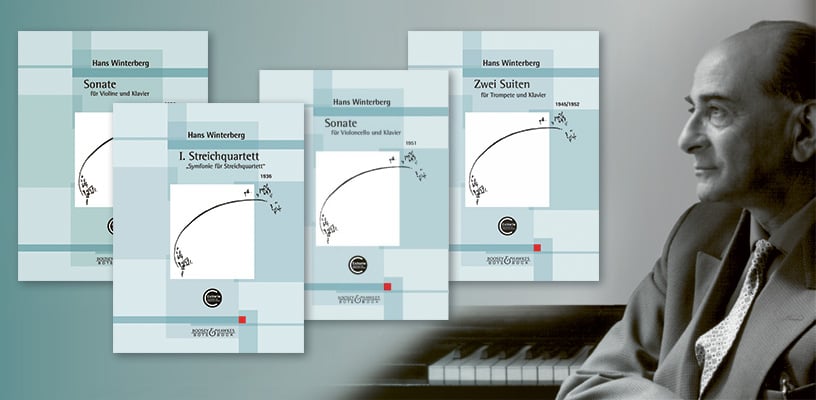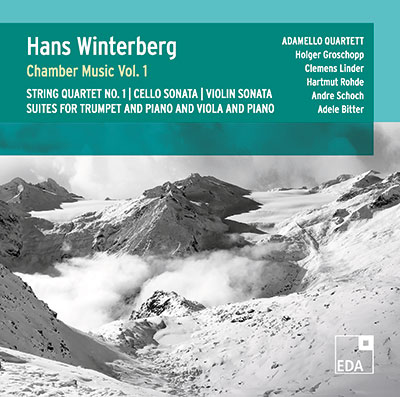Hans Winterberg: first editions of sheet music published

The oeuvre of Hans Winterberg has been revealed to be an immense musical treasure. Under lock and key for many years after the composer's death in 1991, it is now being made accessible and published for the first time by Boosey & Hawkes in cooperation with the Exilarte Centre of the mdw University of Music and Performing Arts Vienna and the composer's grandson.
Hans Winterberg (1901-1991) has only recently been rediscovered as one of the most important representatives of the Czech avant-garde of the first half of the 20th century. Performed but not published during his lifetime, his works were locked away after his death due to tragic circumstances and are now being published for the first time in a collaboration between the Exilarte Centre of the mdw Vienna University of Music and Boosey & Hawkes. In contrast to his colleagues and friends Ullmann, Haas, Krása and Klein, Winterberg survived the Holocaust through a series of miracles. As a pupil of Alexander Zemlinsky and Alois Hába, he is both a successor to Janácek and a member of the wider Second Viennese School.
The current edition project is one of the most comprehensive in the history of the Boosey & Hawkes publishing house, dedicated to a life's work that encompasses numerous compositions of the most diverse genres: orchestral works, solo concertos, ballets, chamber and vocal music. While a number of concert performances and recordings have already been made possible, Winterberg's music is now also accessible to a wider public of musicians, whether professionals or ambitious amateurs, with the first editions of instrumental solo or ensemble works.
These first editions have been published:
String Quartet No. 1 (1936) ‘Symphony for String Quartet’
score and parts | 979-0-2025-3894-4
The work, whose manuscript survived the turmoil of the war and was not premièred until 2024, ‘a masterpiece not only of Czech music but of the entire string quartet repertoire of the 20th century’ (Michael Haas), is perhaps Winterberg's most complex and demanding work from the pre-war period. In terms of the interpretative challenges and the particularities of its stylistic approach, it lies at the interface between the quartets of Janácek and his pupil Pavel Haas and the quartet compositions of the protagonists of the Second Viennese School.
Sonata for cello and piano (1951)
979-0-2025-3810-4
With its three-movement structure and short performance time of less than 13 minutes, the work is characterised by neoclassical restraint - Winterberg is a stranger to chattiness, contemplation and Romantic exuberance. However, conciseness and brevity always go hand in hand with intensity and an exuberant abundance of action in a confined space. ‘Music whose sinews are stretched to the breaking point’ (Frank Harders-Wuthenow).
Sonata for violin and piano (1936)
979-0-2025-3883-8
The Sonata for Violin and Piano, written and premiered in Prague, displays all the characteristics of Winterberg's personal style: a sensuality of sound schooled in French Impressionism with a simultaneous expressionist rigour of harmony, motivic small-mindedness, a sophisticated play with polyrhythmic patterns and, especially in the last movement, a musical impetus borrowed from Czech folklore.
Suite for violin and piano (1942)
979-0-2025-3885-2
Composed in the year in which both Winterberg's mother and his piano professor Thérèse Wallerstein were murdered by the Nazis, the suite is much shorter than the violin sonata from 1936, lasting less than seven minutes. A melody dominated by chromatic turns and expressionist harmony lend the work its melancholy basic character, which gives way to an almost irrepressible defiance in the rhythmically percussive last movement.
Two suites for trumpet and piano (1945 & 1952)
979-0-2025-3904-0
Winterberg composed his two trumpet suites at decisive turning points in his life - the first a few months after his liberation from the Theresienstadt ghetto, the second at the beginning of a promising new beginning as a composer in West Germany, following his emigration there in 1947. While the first suite is still entirely indebted to a Czech idiom, the second shows an orientation towards the tonal language of contemporary music in Germany, particularly Hindemith. Both suites offer a kaleidoscope of moods and technical finesse in a small space.
In preparation:
Suite for viola and piano (1948/49)
979-0-2025-3854-8
Sudeten Suite (1963/64) for piano trio
979-0-2025-3900-2

Parallel to the sheet music edition, the label eda records has just released the first disc in a series devoted to the chamber music by Hans Winterberg, including several first recordings:
Hans Winterberg: Chamber Music Vol. 1
Sonata for Violoncello and Piano | Suite for Viola and Piano | Suite for Trumpet and Piano No. 1 | Sonata for Violin and Piano | String Quartet No. 1 ‘Symphony for String Quartet’
Hartmut Rohde, viola | Andre Schoch, trumpet | Holger Groschopp, piano | Adamello Quartett
eda records EDA 051
> Further information on Work: String Quartet No. 1 'Symfonie für Streichquartett'
